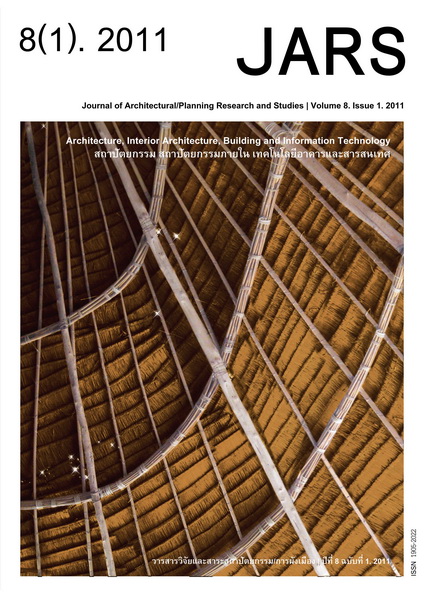Representation, Meanings, and the Political: A Lefebvrian Analysis of Architecture
Main Article Content
Abstract
The interconnections between sociology and the built environment, especially in spatial disciplines
closely aligned to architectural studies, have been widely discussed and criticized by political, social, and
geographical disciplines. By contrast, this occurs rarely within the field of architecture, even though these
socio-spatial dimensions are directly relevant. The paper aims to contribute to the understanding of spatialarchitectural
and social-imaginary relationships by adopting Henri Lefebvre’s dynamic model, in which the
interplay of the inherent design process and the choice of representation generated act as internal and external
factors. Drawing on pertinent literature, phenomena, and interpretations of spatial-social space manipulation, the author posits that politics as an internal and external force has influenced representation. This cannot be overlooked with regard to the creation of a built environment that generates new meanings and memories via recognition and reproduction of space in social-spatial practice.
Downloads
Article Details

This work is licensed under a Creative Commons Attribution-NonCommercial-NoDerivatives 4.0 International License.
All material is licensed under the terms of the Creative Commons Attribution 4.0 International (CC-BY-NC-ND 4.0) License, unless otherwise stated. As such, authors are free to share, copy, and redistribute the material in any medium or format. The authors must give appropriate credit, provide a link to the license, and indicate if changes were made. The authors may do so in any reasonable manner, but not in any way that suggests the licensor endorses you or your use. The authors may not use the material for commercial purposes. If the authors remix, transform, or build upon the material, they may not distribute the modified material, unless permission is obtained from JARS. Final, accepted versions of the paper may be posted on third party repositories, provided appropriate acknowledgement to the original source is clearly noted.
References
Benjamin, W. (1936/1968). The work of art of mechanical reproduction. In H. Arendt (Ed.), Illumination (pp. 217-252). (H. Zohn Trans.). New York: Schocken Books.
Benjamin, W. (1979). One way street and other writings. London: New Left Books.
Charney, I. (2007). The politics of design: Architecture, tall buildings and the skyline of central London. Area, 39(2), 195-205.
Charoensin-O-Larn, C. (2008). การเมืองและความเป็นการเมือง [Politics and the political]. Vibhasa, 1(5), 5.
Crang, M., & Thrift, N. (Eds.). (1997). Thinking space. London: Routledge.
Eco, U. (1997). Function and sign: The semiotics of architecture. In N. Leach (Ed.), Rethinking architecture: A reader in cultural theory (pp. 187-190). London: Routledge.
Foucault, M. (1986). Space, knowledge and power. In P. Rabinow (Ed.), The foucault reader. Harmondsworth: Penguin.
Fraser, B. (2008.) Toward a philosophy of urban: Henri Lefebvre’s uncomfortable application of Bergsonism. Environment and Planning, D, 26, 338-58.
Furjan, H. (2003). Dressing down: Adolf loos and the politics of ornament. The Journal of Architecture, 8(1), 115-130.
Grönlund, B. (1998). ‘The production of space’ - shown as diagrams. In Urbanity: Lived Space and Difference. Retrieved on February 4, 2008, from http://hjem.get2net.dk/gronlund/Lefebvreindlaeg_21_3_97v2.html
Harvey, D. (2007). The Kantian Roots of Foucault’s Dilemmas. In J. W. Crampton & S. Elden (Eds.), Space, knowledge and power: Foucault and geography. Aldershot: Ashgate.
Leach, N. (Ed.). (1997). Rethinking architecture: A reader in cultural theory. London: Routledge.
Lefebvre, H. (1991). The production of space (D. Nicholson-Smith, Trans.). Oxford: Blackwell.
Lefebvre, H. (1996). Writings on cities (E. Kofman & E. Lebas, Trans.). Oxford: Blackwell.
Massey, D. (1998). Power-geometries and the politics of space-time. Heidelberg: Jürgen-J. Sause (HettnerLecture 1998).
Massey, D. (2000). Space-time and the politics of location. In A. Read (Ed.), Architecturally speaking: Practice of art, architecture and the everyday. London: Routledge.
Noobanjong, K. (2008). The National Assembly: An ironic reflection of Thai Democracy. The 10th International Conference on Thai Studies. The Thai Khadi Research Institute, Thammasart University, Bangkok, Thailand, January 9-11. Retrieved January 28, 2008, from www.bookpump.com/dps/pdf-b/1122012b.pdf
Pachathai. (2007, October 18). ‘ศาลฎีกา’ อนุสรณ์สถานเอกราชสมบูรณ์และประวัติศาสตร์การยุติธรรมกำลังถูกทุบทิ้ง [‘Sarn Dhika‘, The liberative monument and the history of ruining justice]. Retrieved January 21, 2008, from http://www.prachatai.com/05web/th/home/page2.php?mod=mod_ptcms&ContentID=9962&SystemModuleKey=HilightNews&SystemLanguage=Thai
Pachathai. (2009, December 13). แบบรัฐสภาใหม่ ความหมายเดิม ๆ [The new parliament design, the unchanged meanings]. Retrieved March 22, 2012, from http://prachatai.com/journal/2009/12/26979
Panin, T. (2006). สัญชาตญาณที่ขาดหายไป: ความขัดแย้งระหว่างเหตุผลและจินตนาการ [The missing instinct: Contradiction between rationale and imagination]. ASA – Journal of Architecture, (October - November), 126-129.
Prakitnontakarn, C. (2005a). ประวัติศาสตร์สุนทรียภาพในเรือนไทย ความงามที่ถูกสร้าง (ตอนที่ 1) [The aesthetic history in Thai house, the constructed beauty (1st Part)]. ASA – Journal of Architecture, (Februay - March), 106-108.
Prakitnontakarn, C. (2005b). ประวัติศาสตร์สุนทรียภาพในเรือนไทย ความงามที่ถูกสร้าง (ตอนที่ 2). [The aesthetic history in Thai house, the constructed beauty (2nd Part)]. ASA – Journal of Architecture, (April - May), 112-115.
Prakitnontakarn, C. (2005c). ฐานานุศักดิ์สถาปัตยกรรมกับความเป็นไทยร่วมสมัย. [Social hierarchical order in architecture and modern Thai character]. ASA – Journal of Architecture, (June - July), 115-117.
Prakitnontakan, C. (2008). Power and memory on the Rajadamnoen avenue in the past sixty years, 1947-2007. Paper presented in the 10th International Conference on Thai Studies, The Thai Khadi research Institute, Thammasart University, Bangkok, January 9-11. Retrieved January 21, 2008, from www.prachathai.com
Savage, M. (2000). Walter Benjamin’s urban thought: A critical analysis. In M. Crang & N. Thrift (Eds.), Thinking space. London: Routledge.
Soja, E. (1996). Thirdspace. Cambridge, Massachusetts: Blackwell.
Tejapira, K. (2007). วัฒนธรรมและจริยธรรมทางการเมือง. [The political culture and moral]. Retrieved November 13, 2007, from http://www.prachatai.com/05web/th/home/10229
Tharapak, R. (2009). สัปปายะสภาสถาน ถอดรหัสรัฐสภาแห่งศีลธรรม. [Sappayasatharn: Decoding the moral parliament]. Retrieved March 22, 2012, from http://www.bangkokbiznews.com/home/news/life-style/
The supreme court must be demolished [ต้องทุบศาลฎีกาทิ้ง]. (2007, October 27). Matichon, p. 9.
Thompson, B. (2007). Hermeneutics for architects?. The Journal of Architecture, 12(2), 183-191.
Vale, L. J. (1992). Architecture, power, and national identity. New Haven, Connecticut: Yale University Press.
Watson, V. (2007). How Henri Lefebvre Missed the modernist sensibility of Mies Van de Rohe: Vitalism at the intersection of a materialist conception if space and a metaphysical approach to architecture. The Journal of Architecture, 12(1), 99-112.


